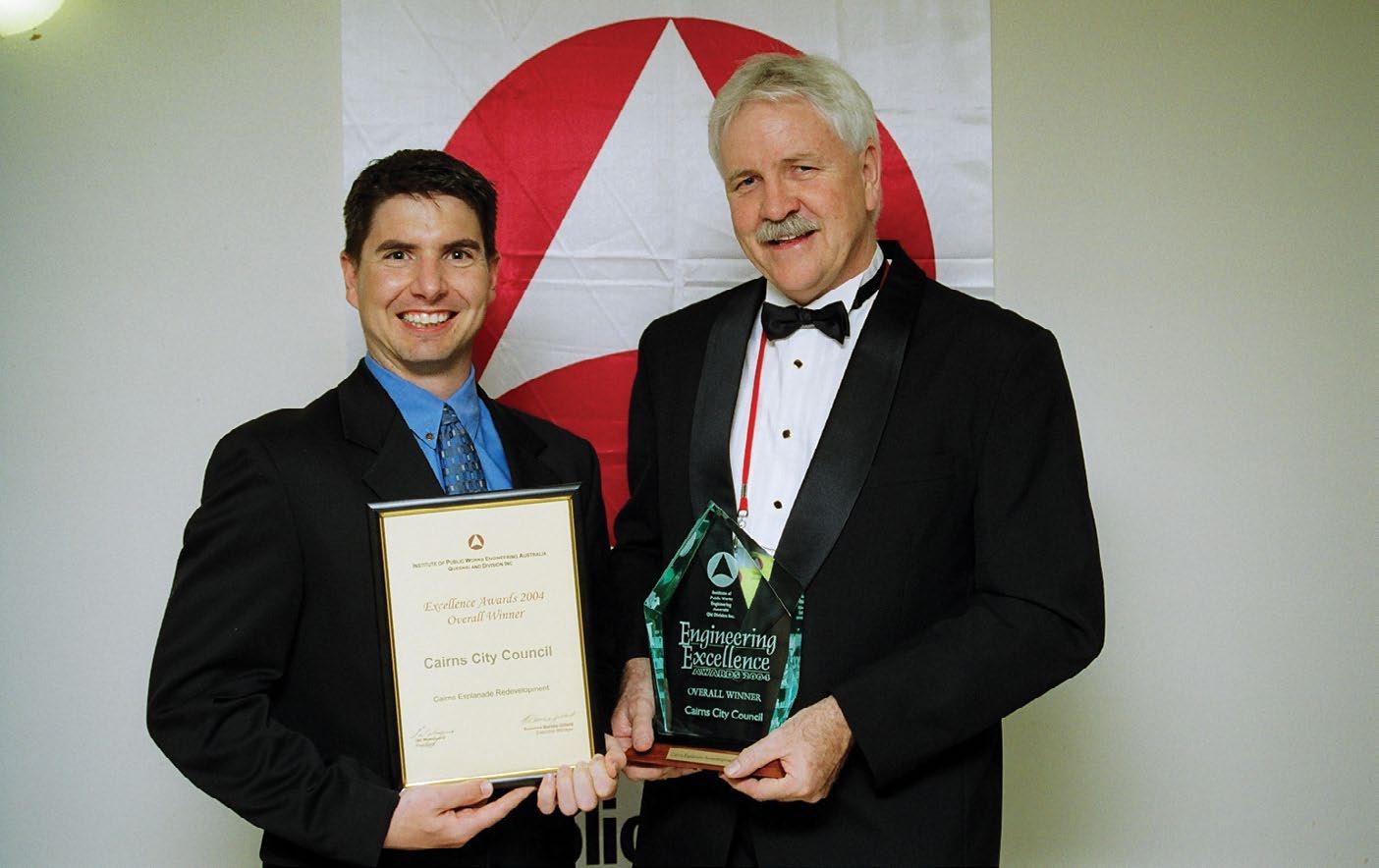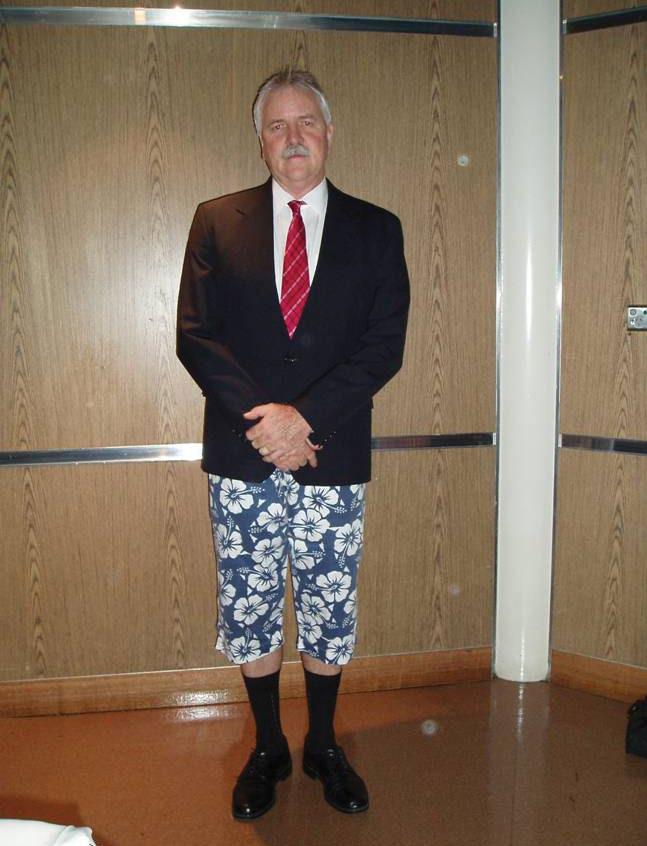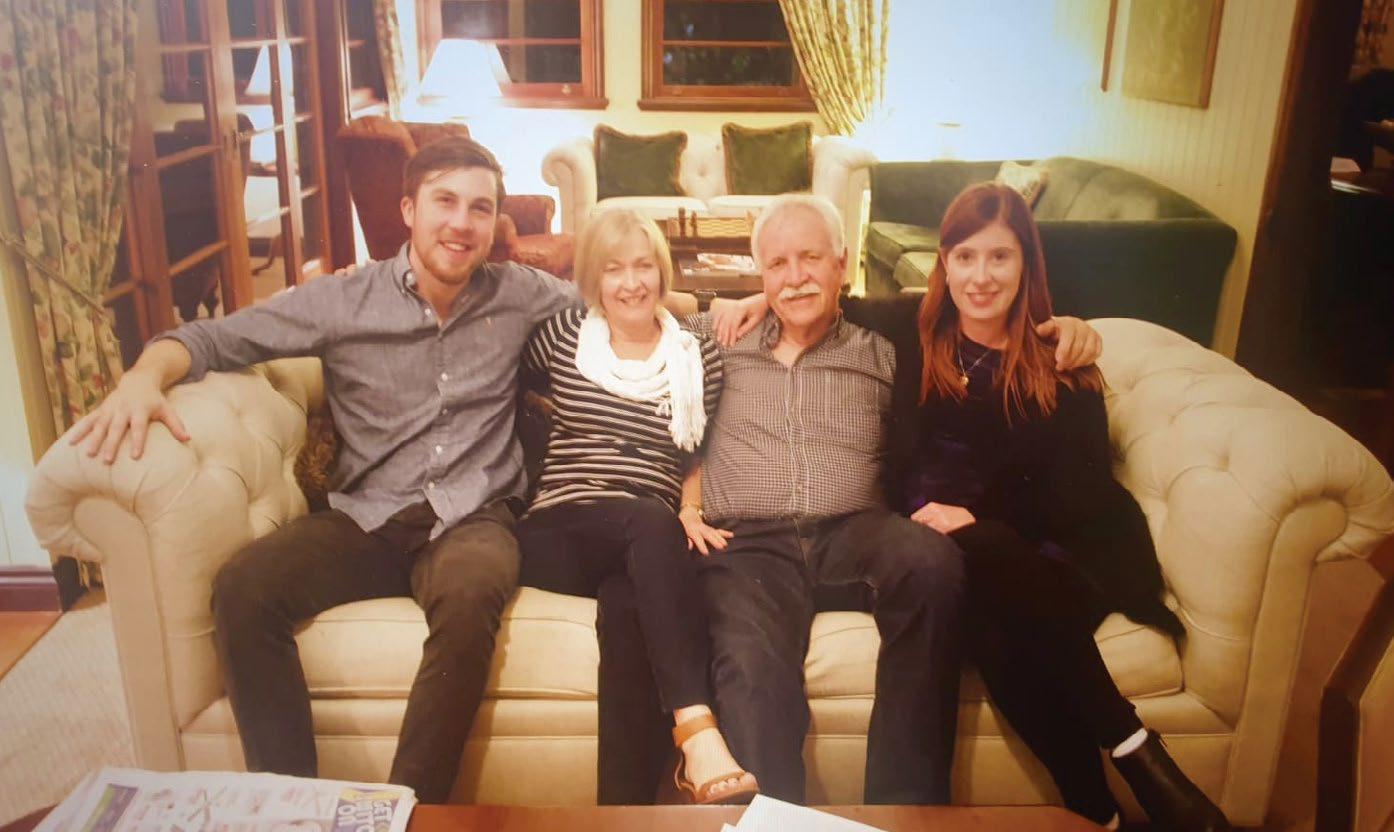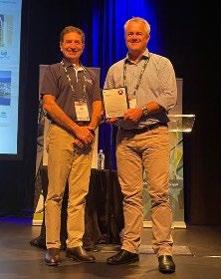
11 minute read
Member Profile, John Hawkes
PAST PRESIDENT
JOHN HAWKES
John initially commenced retirement in late 2009 after a 37-year career in public works engineering, which involved employment in the State Government, Local Government and private sectors. This included almost 18 years working as a leading engineer in a large Far North Queensland Council. After two years, he suspended his retirement for a three-year period to play an active role in the restoration of public infrastructure damaged by Cyclone Yasi in FNQ, including the foreshore and Bruce Highway at Cardwell.
His retirement as a Trustee with the Qld Foundation in 2019 marked the end of 25 years of continuous active service to the Institute with time on both the State and National Boards, the QLD Foundation for PWE and the RPEQ Assessment Board. Over this period, John held the positions of NQ Branch President, State President, National Secretary/Treasurer and Conference Chairman for the 2007 National Conference. He was recognised for his service with the award of Emeritus Member of the Institute in 2009.
Tell us about your career.
I commenced my involvement in engineering in 1969 at the Townsville Campus of UQ as a bonded scholarship holder with the then Main Roads Department in Queensland. I completed my BE (Civil) in 1972 as a graduate of the newly established James Cook University of NQ. The subsequent nine years involved employment with MRD in Cairns, Brisbane and Barcaldine, primarily in a construction engineer and planning and design role. Over that period, I completed a graduate degree in Commerce studying externally with UQ.
I joined Cairns City Council in late 1981 as Assistant Operations Engineer and after progressive promotions and the acquisition of a Local Government Engineers Certificate, I was appointed to the statutory position of City Engineer in 1990.
Except for a two-and-a-halfyear interlude in the late 90s as a private consultant, I remained in the role of senior executive engineer with the same organisation carrying different executive/corporate titles including Director and General Manager until late 2009.
Presentation of the Engineers Australia National Local Government Engineering Medal 2005.
Presentation of the Overall Winner Category of the 2004 IPWEAQ Excellence Awards with then-Council Manager Project Services Michael Kahler.


Cairns Esplanade Lagoon Foreshore Development.
Over that period two separate amalgamations with adjacent local governments had seen the council area’s population grow from 40,000 to 160,000 and the average overnight tourist visitations reach 20,000. At the completion of my time with Cairns Regional Council, I held responsibility for a department within excess of 600 employees.
Albeit unplanned, I returned to work in 2011 for approximately three years to assist DTMRQ and SKM with a $720m undertaking to restore cyclone-damaged infrastructure in FNQ, leading a delivery team of 40 professionals and sub-professionals. Then ‘the cue went firmly back into the rack’.
What was your drive to get into engineering or public works specifically?
The fact that GHD employed my father for 47 years in various engineering roles all around the country had a bearing in this regard. A seemingly natural affinity for science and mathematics while at school also seriously influenced my vocational choice. Notwithstanding this I was conflicted as I approached matriculation by an equal leaning towards a career in medicine. The clincher came with the award of a generous MRD scholarship in an era of otherwise unsubsidised tertiary education. With the benefits of hindsight and the fact that I have seen my son face a similar career choice and take the other option, I have no regrets in this regard.
Being bonded for several years to a State Road Authority, postgraduation, clearly locked me into early involvement with public works.
What projects or experiences have you been involved in that have contributed to your career progression?
I was fortunate that my first posting with MRD as a graduate engineer was to Peninsula District as a site engineer on some of the largest and most challenging road construction projects outside of Brisbane. At the time, this District had a large, well-resourced and well-trained day labour force so I gained some particularly good handson experience backed by the department’s comprehensive graduate training program. My time in this District provided me with a good grounding in engineering and construction in the tropics and provided an interesting contrast to my subsequent, albeit relatively brief, posting to the arid central west centred on Barcaldine.
After nine years of gaining considerable experience in most aspects of road transport engineering, my move to local government allowed me to broaden my experience to the many other areas of public works engineering that fall into the arena of this multi-faceted industry. With Cairns entering one of its most significant development booms, mainly associated with the establishment of its international airport, there could not have been a better time to join that organisation.
My early perception of the scope for organisational reform in council, starting with my own area of operations, led me to the pursuit and implementation, with staff support, of many improvements in our structure, processes and culture. The patent success of these changes led to broader organisational

IPWEAQ Board 2001 - 2003. Adelaide 2005 promoting serious business in a spectacular location.

reform and ultimately to council being one of the first in Australia to adopt a Total Quality Management Framework to cover its operations. My interest and activity in this area served as a platform for my elevation to long-term membership of council’s executive management team including regular opportunities to head up that team as the Acting CEO.
Can you identify one (or more) career highlights to date?
From a project perspective, it would be my involvement in what is now regarded as Cairns’ iconic Esplanade Lagoon and Foreshore Development, photos of which now regale almost all tourism promotional material for the city and region. This $53m project received, among other accolades, the IPWEAQ Best Overall Project Excellence Award in 2004 and the Engineers Australia National Local Government Engineering Medal in 2005, both of which I had the honour of receiving on behalf of council and its project team.
From a purely professional perspective, it would have been the award of Emeritus Membership of IPWEA in 2009 which, timed with my final separation from local government, was truly ‘icing on the cake’.
What did you enjoy most about working as an engineer in public works?
There can be few things more rewarding than having the opportunity to create and maintain infrastructure that has a demonstrable impact on the community’s quality of life and safety in general and, even more so, of the community in which you live. No other engineering endeavour can match the dayto-day diversity of public works engineering, particularly local government engineering where many engineers have to be true general practitioners of their profession to adequately perform their roles and meet their responsibilities.
I should add that being a lover of the great outdoors, at no time during my career was there never a premise to leave the office to carry out a site inspection.
What do you appreciate most about IPWEAQ’s involvement in your career?
I regard one of the defining days in my career as being one in February 1995. I received a phone call from the then Executive Director of IMEAQ, Ray Moore, inviting me to join the State Board as the FNQ Representative. That marked the commencement of an 11year stint on the Board which included a concurrent four years as a Director on the IPWEA National Board from 2001 – 2005. I cannot overstate the positive impact this level of involvement in the Institute had, both on my career and my personal life. Although superimposed on an already time-demanding occupation, the rewards more than justified the challenge of finding the time required. It provided me with a network of peers (and long-term friends) both across the state and the nation and allowed me to be directly involved in high level advocacy for public works engineers and the formulation of government policies which impact on them.
What key advice have you received and/or would you give to others entering the industry?
My advice to young engineers entering a public works environment who have not already undertaken a joint degree involving business/ finance, is to try and add such a string to your bow as soon as possible. There is no substitute for financial literacy in most of the work you will be involved in, not to mention your everyday personal affairs, and you will find this knowledge will facilitate early career progression.

Wilderness hiking, a favourite retirement activity.

Relaxing with family post retirement.
I would also strongly advise, not only membership of the Institute, but also the first possible opportunity to become actively involved with it.
My father’s words of “always be kind to the people under you’’ is my recollection of the earliest advice given to me as I was about to enter the industry which, although basic, if followed will return many dividends.
What struggles have you encountered within the industry, and how did you overcome them?
Although a strong supporter, in principle, of council amalgamations I have struggled on two occasions in dealing with the fallout from the poorly managed implementation of them. Where the politics and culture between the councils involved are significantly different my experience indicates that the initial merger of pre-existing administrations would be better served under an independent administrator’s oversight rather than a newly elected council. Although challenging, I found that the associated issues were not insurmountable and could be overcome with strong leadership and perseverance.
The biggest struggle I faced towards the end of my career, along with many of my colleagues, was the shortage of engineers in the industry. The drop in the number of students studying STEM subjects in high schools during the mid to late 90s combined with the attraction of many graduate and experienced engineers to the mining sector created a dearth of engineers in the public sector during the first decade of this century. With the requirement for many engineers in my team to deliver council’s programs, the protracted periods of less than a full complement created challenges that generally could only be mitigated by existing staff going the extra mile.
To try and encourage a move back towards interest in high school STEM, IPWEAQ put together, during my time on the Board, a promotional package including a website labelled Engineering Fully Loaded for use as vocational guidance at high schools.
Is there anything else you believe is important to note?
I would like to take this opportunity to recognise Suzanna Barnes-Gillard, who in joining IPWEAQ in 2001 in the role of Executive Director and the first full-time employee of the organisation, made it possible for me as President at the time and the rest of the Board to focus entirely on our intended role as directors. While the prior arrangement involving part-time executive support had delivered many positive outcomes for the organisation it placed a significant onus on the voluntary members of the Board, who, generally as city and shire engineers, already had challenging work commitments. Suzanna’s expertise, energy and entrepreneurial spirit allowed the directors to be less involved in policy implementation and more in policy creation. Her arrival in the organisation marked a true watershed moment in the history of IPWEAQ and created a platform for its development into the thriving and successful organisation that it currently is.
INFORMS. CONNECTS. REPRESENTS. LEADS.
Street Design Manual for Practitioners

Up to 8 CPD hours
Streets and pathways are the building blocks of every residential neighbourhood. Along with our built environment, well-planned streets and neighbourhoods infl uence how people move and interact, access parks and open space, walk and cycle for leisure, recreation, exercise and transport.
IPWEAQ’s Street Design Manual: Walkable Neighbourhoods (the Manual) is a contemporary guide for the design and development of Queensland’s residential neighbourhoods. Developed for industry by industry, the Manual recognises streets as an essential connector to multi-purpose social spaces in our neighbourhoods. It off ers access options for active transport delivering safer neighbourhoods and a sense of community. This program will provide a detailed understanding of all aspects of quality contemporary residential land development that promotes healthy and safe communities, and provide a more coordinated approach to neighbourhood planning and design for councils, developers and the community. Outcomes
Participants will gain a sound understanding of the intent and application of the Street Design Manual to assist in planning and design applications that complement current regulatory requirements.
Who should attend
This program has been designed for Industry Practitioners working in the Planning and Design of contemporary residential neighbourhoods, including those working in both private and government organisations. Typical attendees include: Planners, Designers, Engineers, Development Managers, Technicians
Learning Strategies
Lectures, Case studies, Group Discussions, Practical Activities
Topics
Introducing the Street Design Manual: Walkable neighbourhoods, An overview of the need, intent and strategies that led to the development of the SDM. Part 1 Check Element 1: Community Design Check Element 2: Movement Network –
Concept Design Check Element 3: Neighbourhood Open Space
Network Check Element 4: Lot Design Check Element 5: Activity Centres
Part 2 Check Element 1: Introduction Check Element 2: Active Transport Check Element 3: Public Transport Check Element 4: Motor Vehicles Check Element 5: The Residential Street Check Element 6: Design Detail – Related
Infrastructure
Part 3 Check Practice notes
Facilitators
The program will be facilitated by Planning and Design professionals.
Attendees will be provided with a complementary hard copy of the Manual








